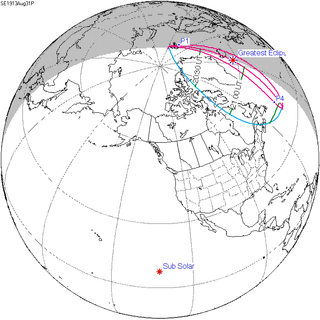A partial solar eclipse occurred at the Moon's descending node of orbit on Sunday, August 31, 1913,[1][2] with a magnitude of 0.1513. A solar eclipse occurs when the Moon passes between Earth and the Sun, thereby totally or partly obscuring the image of the Sun for a viewer on Earth. A partial solar eclipse occurs in the polar regions of the Earth when the center of the Moon's shadow misses the Earth.
| Solar eclipse of August 31, 1913 | |
|---|---|
| Type of eclipse | |
| Nature | Partial |
| Gamma | 1.4512 |
| Magnitude | 0.1513 |
| Maximum eclipse | |
| Coordinates | 61°30′N 26°48′W / 61.5°N 26.8°W |
| Times (UTC) | |
| Greatest eclipse | 20:52:12 |
| References | |
| Saros | 114 (71 of 72) |
| Catalog # (SE5000) | 9312 |
Related eclipses
editEclipses in 1913
edit- A total lunar eclipse on March 22, 1913.
- A partial solar eclipse on April 6, 1913.
- A partial solar eclipse on August 31, 1913.
- A total lunar eclipse on September 15, 1913.
- A partial solar eclipse on September 30, 1913.
Metonic
edit- Followed by: Solar eclipse of June 19, 1917
Tzolkinex
edit- Preceded by: Solar eclipse of July 21, 1906
Tritos
edit- Followed by: Solar eclipse of July 31, 1924
Solar Saros 114
edit- Preceded by: Solar eclipse of August 20, 1895
- Followed by: Solar eclipse of September 12, 1931
Inex
edit- Followed by: Solar eclipse of August 12, 1942
Triad
edit- Preceded by: Solar eclipse of October 31, 1826
- Followed by: Solar eclipse of July 1, 2000
Solar eclipses of 1913–1917
editThis eclipse is a member of a semester series. An eclipse in a semester series of solar eclipses repeats approximately every 177 days and 4 hours (a semester) at alternating nodes of the Moon's orbit.[3]
| Solar eclipse series sets from 1913 to 1917 | ||||
|---|---|---|---|---|
| Descending node | Ascending node | |||
| 114 | August 31, 1913 Partial |
119 | February 25, 1914 Annular | |
| 124 | August 21, 1914 Total |
129 | February 14, 1915 Annular | |
| 134 | August 10, 1915 Annular |
139 | February 3, 1916 Total | |
| 144 | July 30, 1916 Annular |
149 | January 23, 1917 Partial | |
| 154 | July 19, 1917 Partial | |||
Saros 114
editThis eclipse is a part of Saros series 114, repeating every 18 years, 11 days, and containing 72 events. The series started with a partial solar eclipse on July 23, 651 AD. It contains annular eclipses from February 3, 976 AD through June 11, 1192; hybrid eclipses from June 22, 1210 through December 1, 1480; and total eclipses from December 13, 1498 through June 15, 1787. The series ends at member 72 as a partial eclipse on September 12, 1931. Its eclipses are tabulated in three columns; every third eclipse in the same column is one exeligmos apart, so they all cast shadows over approximately the same parts of the Earth.
The longest duration of annularity was produced by member 20 at 4 minutes, 33 seconds on February 13, 994 AD, and the longest duration of totality was produced by member 59 at 4 minutes, 18 seconds on April 21, 1697. All eclipses in this series occur at the Moon’s descending node of orbit.[4]
| Series members 65–72 occur between 1801 and 1931: | ||
|---|---|---|
| 65 | 66 | 67 |
| June 26, 1805 |
July 8, 1823 |
July 18, 1841 |
| 68 | 69 | 70 |
| July 29, 1859 |
August 9, 1877 |
August 20, 1895 |
| 71 | 72 | |
| August 31, 1913 |
September 12, 1931 | |
Metonic series
editThe metonic series repeats eclipses every 19 years (6939.69 days), lasting about 5 cycles. Eclipses occur in nearly the same calendar date. In addition, the octon subseries repeats 1/5 of that or every 3.8 years (1387.94 days).
| 22 eclipse events, progressing from north to south between April 8, 1902, and August 31, 1989: | ||||
|---|---|---|---|---|
| April 7–8 | January 24–25 | November 12 | August 31-September 1 | June 19–20 |
| 108 | 114 | 116 | ||
| April 8, 1902 |
August 31, 1913 |
June 19, 1917 | ||
| 118 | 120 | 122 | 124 | 126 |
| April 8, 1921 |
January 24, 1925 |
November 12, 1928 |
August 31, 1932 |
June 19, 1936 |
| 128 | 130 | 132 | 134 | 136 |
| April 7, 1940 |
January 25, 1944 |
November 12, 1947 |
September 1, 1951 |
June 20, 1955 |
| 138 | 140 | 142 | 144 | 146 |
| April 8, 1959 |
January 25, 1963 |
November 12, 1966 |
August 31, 1970 |
June 20, 1974 |
| 148 | 150 | 152 | 154 | |
| April 7, 1978 |
January 25, 1982 |
November 12, 1985 |
August 31, 1989 | |
References
edit- ^ "THREE ECLIPSES IN NEXT TWO MONTHS". The Roanoke Times. Roanoke, Virginia. 1913-08-13. p. 3. Retrieved 2023-11-04 – via Newspapers.com.
- ^ "The second solar eclipse of the year". Star Tribune. Minneapolis, Minnesota. 1913-08-31. p. 28. Retrieved 2023-11-04 – via Newspapers.com.
- ^ van Gent, R.H. "Solar- and Lunar-Eclipse Predictions from Antiquity to the Present". A Catalogue of Eclipse Cycles. Utrecht University. Retrieved 6 October 2018.
- ^ "NASA - Catalog of Solar Eclipses of Saros 114". eclipse.gsfc.nasa.gov.
External links
edit- Earth visibility chart and eclipse statistics Eclipse Predictions by Fred Espenak, NASA/GSFC
